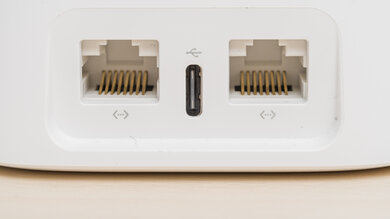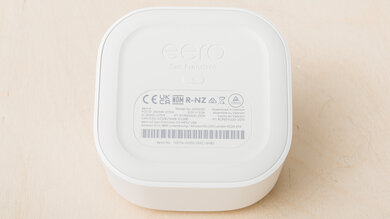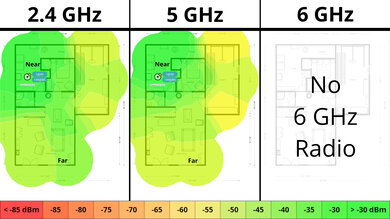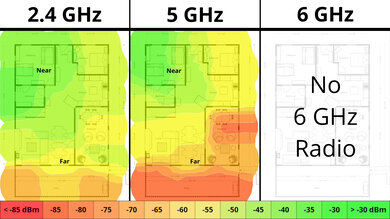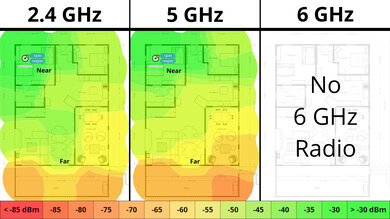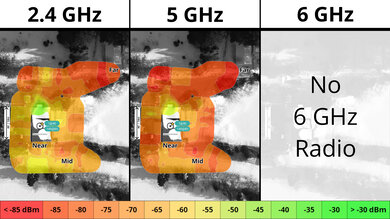The eero 6 is a dual-band Wi-Fi 6 router with a 2.4GHz and a 5GHz band. It's designed to work in a mesh system with other access points and is available as a standalone router or in various multi-packs. Like other eero routers, it has a minimalistic design with a small footprint and a sleek white finish. It features a built-in Zigbee smart home hub and supports Amazon Alexa. You can manage it through eero's mobile app, where you can configure basic settings. The app has a paid subscription tier that allows you to access additional features like ad blocking, content filters, and a VPN. We bought and tested a two-pack with one router and one extender and tested it in mesh and standalone modes.
Our Verdict
The eero 6 is a good router if you live in an apartment, condo, or small house. Its small size and sleek design make it easy to place in your living space. Even with a single unit, it provides decent coverage that'll be fast and stable enough for most internet activities, like 4k video streaming. Its network ports are only capable of single-gigabit speeds, so you'll be limited if you have wired devices capable of multi-gigabit speeds or have an internet plan faster than 1 Gbps.
-
Small and sleek design.
-
Built-in smart home integration.
-
Very good top speeds.
-
Only two networking ports that are both limited to single-gigabit speeds.
-
Have to pay an additional subscription fee for advanced features.
-
Newer Wi-Fi 6E and 7 devices won't reach their full speeds on this Wi-Fi 6 router.
The eero 6 is a good router if you have a multi-level house. Its speeds and network coverage are decent and suitable for most high-bandwidth uses like 4k video streaming, but it won't be as consistent if you're far away from it on another floor or deep into your backyard. You can easily add more access points to improve your network coverage. It only has two networking ports, and they're only rated for single-gigabit speeds, so your multi-gigabit devices will be limited.
-
Small and sleek design.
-
Decent range performance.
-
Built-in smart home integration.
-
Can add additional mesh access points to improve range.
-
Very good top speeds.
-
Only two networking ports that are both limited to single-gigabit speeds.
-
Have to pay an additional subscription fee for advanced features.
-
Newer Wi-Fi 6E and 7 devices won't reach their full speeds on this Wi-Fi 6 router.
The eero 6 delivers very good speeds suitable for an internet connection of up to 700 Mbps. It also supports Dynamic Frequency Selection (DFS), so it can use less congested DFS-only channels to give you better speeds in noisy wireless environments.
-
Very good top speeds.
-
Newer Wi-Fi 6E and 7 devices won't reach their full speeds on this Wi-Fi 6 router.
The eero 6 has decent range performance. It's a mesh router that uses satellite units to maintain consistent speeds over long distances.
-
Decent range performance.
-
Can add additional mesh access points to improve range.
Changelog
-
Updated Dec 06, 2024:
We've added links to the newly reviewed ASUS ROG Rapture GT6 and NETGEAR Nighthawk RS300 in the Network Ports section of this review.
- Updated Jul 22, 2024: Review published.
Check Price
Differences Between Sizes And Variants
The eero 6 is available as a standalone router or in various multi-packs. The multi-packs either have multiple routers or one router and extenders. The difference between the routers and the extender units is that the extender doesn't contain any wired networking ports, so you can't connect them to the main router using an Ethernet cable.
eero also sells the eero 6+, which is nearly identical to this router but supports the 160MHz channel bandwidth for faster speeds.
We bought a two-pack with one router and one extender and tested it in both mesh and standalone modes. Here's a photo of our unit's label.
Compared To Other Routers
The eero 6 is eero's entry-level dual-band Wi-Fi 6 router with a 2.4GHz band and a 5GHz band. Like eero's other routers, it's designed to expand easily into a mesh network with other access points. It has good smart home functionality compared to other routers in its class, as it works as a hub compatible with Amazon Alexa and supports Thread and Zigbee devices. eero offers an "eero Plus" membership that allows you to access advanced settings and additional features like ad blocking, content filters, and VPN access.
This router is a decent Wi-Fi 6 option that stands out for its ease of use and setup, integration with smart home features, and sleek design. That said, while the eero app is convenient and easy to use, it's not very flexible, as there are very few configurable options that you can change compared to standalone routers and even some other mesh systems.
If you're looking for more options, check out our recommendations for the best Wi-Fi routers, the best mesh Wi-Fi systems, and the best Wi-Fi 6 routers.
The eero 6 is a much better router than the Google Wifi. They're both routers that you can buy in multi-packs and are intended for use in a mesh network. The Google is only Wi-Fi 5, and its performance is disappointing at longer distances. On the other hand, the eero is Wi-Fi 6, performs much better at range, and has faster top speeds.
The eero Pro 6 and the eero 6 are both Wi-Fi 6 routers designed for mesh networking. The main difference between the two is that the Pro 6 has three bands (a 2.4GHz band and two 5GHz bands), while the 6 only has two bands. The Pro 6 has better speeds and range but is a bit bigger.
The eero 6 and the UniFi Dream Router are Wi-Fi 6 routers. The eero is a consumer-grade product that's designed to be easy to use. Whereas, the UniFi is closer to an enterprise-grade product that offers incredibly in-depth configuration and compatibility with a wide ecosystem of networking products, including additional access points to create a mesh network. Both routers offer similar performance—the eero has a better range because we tested it in a mesh configuration with two access points.
Test Results
This router has two networking ports that automatically detect whether you use a WAN or LAN connection. However, you'll have to buy an external network switch if you have many wired devices.
The extender has no networking ports, so you can only connect it to the main router wirelessly. See the back of it here. If you need networking ports on the satellite units, eero sells a three-pack with networking ports on the back.
If you're looking for a router with better wired connectivity, check out the ASUS ROG Rapture GT6 or the NETGEAR Nighthawk RS300.
While this router has a USB-C port, it's only for power and doesn't support data transfer.
We tested this router in dual mesh mode. While there's a slight speed penalty when connected to the satellite, this is expected, and the additional access point helps deliver more consistent speeds over very long distances.
We tested this router in dual mesh mode. There's a slight speed penalty when connected to the satellite, but this is expected. A satellite unit is likely unnecessary if you have a smaller home without dead zones or obstacles like concrete walls.
Comments
eero 6: Main Discussion
Let us know why you want us to review the product here, or encourage others to vote for this product.
Update: We’ve added links to the newly reviewed ASUS ROG Rapture GT6 and NETGEAR Nighthawk RS300 in the Network Ports section of this review.



